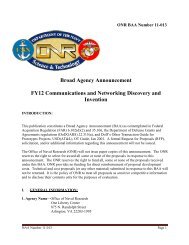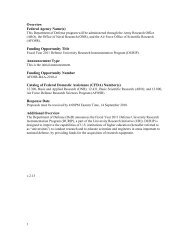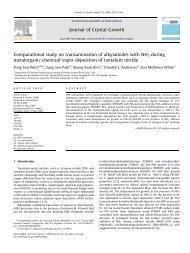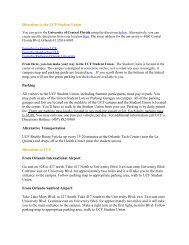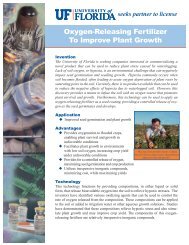Sept 2001 Rough Draft OFFM Policy Letter 02-1 - Office of Research ...
Sept 2001 Rough Draft OFFM Policy Letter 02-1 - Office of Research ...
Sept 2001 Rough Draft OFFM Policy Letter 02-1 - Office of Research ...
Create successful ePaper yourself
Turn your PDF publications into a flip-book with our unique Google optimized e-Paper software.
techniques that will result in increased algal biomass productivity in outdoor cultivation<br />
environments relevant to commercial scales (i.e., one (1) acre cultivation equivalent).<br />
Achieving a target for a minimum ash free dry weight (AFDW) productivity will not be the only<br />
variable that will enable meeting the goal <strong>of</strong> 2,500 gallons <strong>of</strong> bi<strong>of</strong>uel intermediate per acre per year<br />
by 2018. However, achieving high levels <strong>of</strong> algal biomass productivity continues to be one <strong>of</strong> the<br />
most significant contributors to achieving an economically viable algal bi<strong>of</strong>uels industry. BTO’s<br />
baseline analysis results show that conservative modeled productivities (13 grams per meter<br />
squared per day – g/m2/day on an annual average basis) are associated with high resource use, high<br />
costs, and high GHG emissions for algal bi<strong>of</strong>uel systems. Priority Area 1 is focused on<br />
demonstrating increased algal biomass productivity that, in combination with improvements in<br />
other downstream processes, will meet the bi<strong>of</strong>uel intermediate productivity goal <strong>of</strong> 2,500 gallons<br />
per acre per year by 2018.<br />
It is recognized that productivities above 25 g/m2/day are achievable in the lab and that advanced<br />
biotechnology may further increase this, but a clear barrier exists in translating laboratory success<br />
to demonstrated, scalable, outdoor cultivation environments that capture all <strong>of</strong> the variables not<br />
present in laboratory systems. Thus, it is expected that the research conducted in the selected<br />
projects will include an iterative process whereby the results obtained from experiments in outdoor<br />
environments will be used to inform the laboratory experiments and vice versa. This continuous<br />
feedback loop is expected to expedite the lessons learned and ensure they are relevant for large<br />
scale algal bi<strong>of</strong>uel production.<br />
Important aspects <strong>of</strong> Priority Area 1 include:<br />
Production <strong>of</strong> algal feedstock refers to the cultivation <strong>of</strong> both micro- and macro-alga, as well<br />
as cyanobacteria. (See Appendix A for a definition <strong>of</strong> allowable algal types.)<br />
Improvements to increase algal biomass productivity may include, but are not limited to:<br />
advances made to systems biology approaches; gains in knowledge related to fundamental<br />
algal processes (e.g., photosynthesis); strain improvement from breeding to modification<br />
and/or genetic engineering; improvements in cultivation strategies, such as crop protection,<br />
water and nutrient management, carbon dioxide delivery and utilization, light optimization,<br />
temperature management, and seasonal succession; and cultivation infrastructure<br />
engineering to maximize biomass yields while minimizing land, capital, and operating costs.<br />
Acceptable algae cultivation systems include open ponds, attached growth systems, and<br />
closed photobioreactors (PBRs), combinations <strong>of</strong> these systems, or other systems with<br />
similarly justifiable scalable potential.<br />
There are a wide variety <strong>of</strong> processes that may use various components <strong>of</strong> the algal<br />
feedstocks on the path towards commercialization <strong>of</strong> bi<strong>of</strong>uels, and possibly bioproducts. As<br />
such, all <strong>of</strong> the major bulk biochemical components (lipid, protein, carbohydrate, and ash)<br />
are targets for improvements if they can be clearly demonstrated to lead to increased yields<br />
<strong>of</strong> bi<strong>of</strong>uel intermediates. Thus, the productivity <strong>of</strong> all <strong>of</strong> these components will be<br />
considered under this FOA.<br />
It is expected that applicants will have already identified: promising strain(s) or partnered<br />
appropriately to gain access to identified strains; strain characteristic(s); and cultivation<br />
technique(s) backed by supporting data that demonstrate(s) a significant potential to<br />
increase biomass productivity. This information must be included in the application.<br />
Standardized analytical methods for measuring the key biochemical constituents are vital to<br />
8




